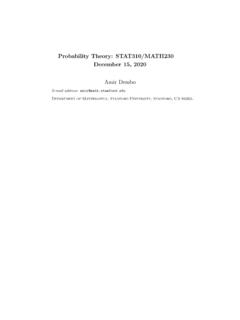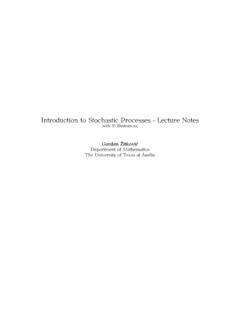Markov Chains On Countable State Space 1 Markov Chains Introduction
Found 8 free book(s)An introduction to Markov chains
web.math.ku.dkmodels for random events namely the class of Markov chains on a finite or countable state space. The state space is the set of possible values for the observations. Thus, for the example above the state space consists of two states: ill and ok. Below you will find an ex-ample of a Markov chain on a countably infinite state space, but first
Chapter 1 Markov Chains - Yale University
www.stat.yale.edu2 1MarkovChains 1.1 Introduction This section introduces Markov chains and describes a few examples. A discrete-time stochastic process {X n: n ≥ 0} on a countable set S is a collection of S-valued random variables defined on a probability space (Ω,F,P).The Pis a probability measure on a family of events F (a σ-field) in an event-space Ω.1 The set Sis the state space of the …
Probability Theory: STAT310/MATH230 April15,2021
statweb.stanford.eduChapter 6. Markov chains 229 6.1. Canonical construction and the strong Markov property 229 6.2. Markov chains with countable state space 237 6.3. General state space: Doeblin and Harris chains 260 Chapter 7. Ergodic theory 275 7.1. Measure preserving and ergodic maps 275 7.2. Birkhoff’s ergodic theorem 279 3
Probability Theory: STAT310/MATH230;August 27, 2013
web.stanford.eduChapter 6. Markov chains 227 6.1. Canonical construction and the strong Markov property 227 6.2. Markov chains with countable state space 235 6.3. General state space: Doeblin and Harris chains 257 Chapter 7. Continuous, Gaussian and stationary processes 271 7.1. Definition, canonical construction and law 271 7.2. Continuous and separable ...
Lecture 4: Continuous-time Markov Chains
cims.nyu.edu4.1 Definition and Transition probabilities Definition. Let X =(X t) t 0 be a family of random variables taking values in a finite or countable state space S, which we can take to be a subset of the integers. X is a continuous-time Markov chain (ctMC) if it satisfies
Schaum's Outline of
webpages.iust.ac.irProbability 1 1.1 Introduction 1 1.2 Sample Space and Events 1 1.3 Algebra of Sets 2 ... 5.5 Discrete-Parameter Markov Chains 165 5.6 Poisson Processes 169 5.7 Wiener Processes 172 ... or countably infinite sample points (as in Example 1.2). A set is called countable if its elements can be placed in a one-to-one correspondence with the positive ...
Introduction to Markov Chain Monte Carlo
www.cs.cornell.eduMarkov Chains Fundamental Properties Proposition: – Assume a Markov Chain with discrete state space Ω. Assume there exist positive distribution on Ω ( (i)>0 and ∑ i (i) = 1) and for every i,j: (i)p ij = (j)p ji (detailed balance property) then is the stationary distribution of P Corollary:
Introduction to Stochastic Processes - Lecture Notes
web.ma.utexas.eduThe set [0;1] of all real numbers between 0 and 1 is not countable; this fact was first proven by Georg Cantor who used a neat trick called the diagonal argument . 1.3 Discrete random variables
Similar queries
Introduction, Markov Chains, Countable state space, State space, Markov, 1 Markov Chains, 1 Introduction, Countable, Space, Probability, Chains, Probability Theory: STAT310/MATH230;August, Lecture 4: Continuous-time Markov Chains, Schaum, Probability 1 1, 1 Introduction 1 1, Introduction to Markov Chain Monte, Stochastic







